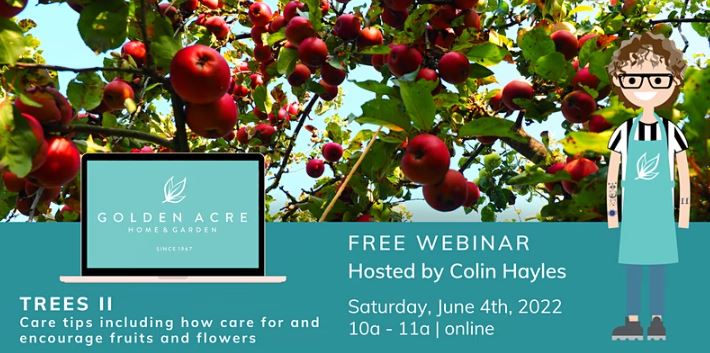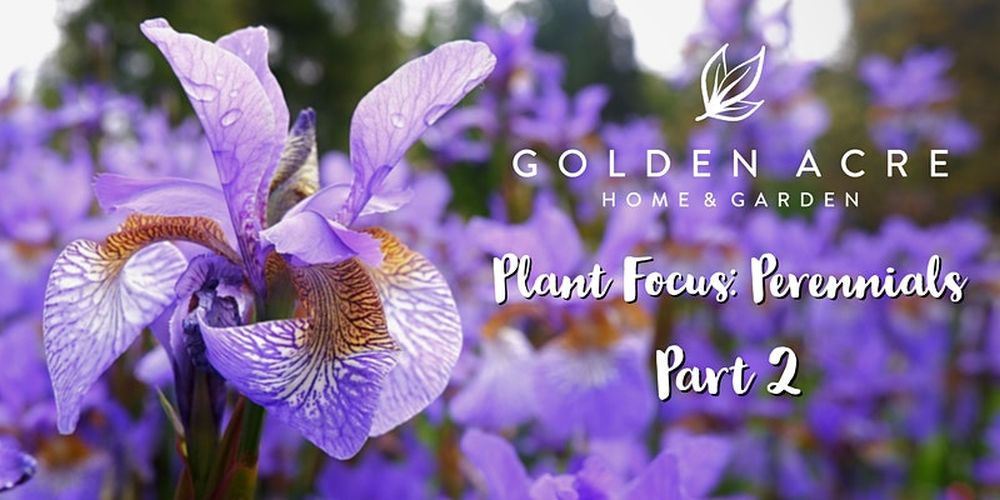How’s the garden coming along? What do you have growing right now? Annuals? Perennials? Veggies? Shrubs? A majestic apple tree? I hope you are having a blast and being safe out there with your SPF and sunglasses.
Thank you to everyone who attended our Perennials webinar this morning. There was a bit of confusion due to technical errors but we have checked the next webinars and will not be running into the same issue. We hope you can join us for some exciting topics coming up like birding and watering.
This week, we expanded on perennials and went into detail about care, transplanting, dividing, and touched on some common myths you hear surrounding them (that part is my fav!).
If you missed our webinar, it is now available on YouTube and you can grab Colin’s PowerPoint here: GA Webinar – Plant Focus: Perennials Part 2 Return of the Iris Here’s a recap: What is a Perennial:
- A herbaceous plant that lives more than two years (including weeds!).
- Example: Echinacea, Ferns, Hosta, Sedum, Spurge, etc
- Weed Example: Dandelion, Creeping Bell Flower, etc.
 Purpose of Perennials (Colin Term: Purposennial?)
Purpose of Perennials (Colin Term: Purposennial?)
- Pollination
- Soil Support
- Year-round growth for established gardens
- Water conservation
- Sustainable
 Transplanting
Transplanting
- Process of moving a fully germinated seedling (or mature plant) and replanting it in another location for the growing season
- Do this:
- Early spring for summer/fall flowering perennials
- Early fall for spring-flowering perennials
- Procedure:
- Dig and prep the plant’s new home. You don’t want roots exposed for too long.
- Use a clean and sharp shovel to dig around the plant.
- A good rule: Ensure you’re not disrupting roots too much. Start digging a little wider than the plant
- Lift as much of the root ball as possible and plant right away.
- Backfill with quality amended soil – 50/50 or 33/66 ratio.
- Amended soil combines compost like Sea Soil with existing topsoil.
- Give the newly planted perennial a good drink of water.
- Fertilize with root booster or transplanter fertilizer.
- Look for a high middle number like 5-15-5.
- IMPORTANT: Follow instructions on your specific fertilizer.
- Process of lifting the perennial and cutting the root ball to multiply the plant
- Do this:
- Early spring for summer/fall flowering perennials
- Early fall for spring-flowering perennials
- Procedure:
- Dig and prep the plant’s new home. You don’t want roots exposed for too long.
- Use a clean and sharp shovel to dig around the plant.
- A good rule: Ensure you’re not disrupting roots too much. Start digging a little wider than the plant
- Lift as much of the root ball as possible and plant right away.
- Cleanly cut the perennial as evenly as possible.
- A clean cut will ensure the plant recovers quicker… kind of like when we get a cut. a cleaner wound will heal faster.
- Backfill with quality amended soil – 50/50 or 33/66 ratio.
- Amended soil combines compost like Sea Soil with existing topsoil.
- Give the newly planted perennial a good drink of water.
- Fertilize with root booster or transplanter fertilizer.
- Look for a high middle number like 5-15-5.
- IMPORTANT: Follow instructions on your specific fertilizer.
Myth: Peonies require ants in order to bloom.
Busted! Peony is a high production plant. They present BIG blooms which require a lot of energy. Peony’s get that energy from sugar which is why it looks sticky. The ants are attracted to sweet things and so that’s why you see ants around peonies. Thinking about this: If you cut peonies to display in your house, do you bring ants inside too?
**************
Myth: Perennials need to be divided every three years!
Busted! You don’t need to put your perennials on a division schedule. You can divide perennials when/if you need to improve their growing conditions due to changes in the yard, or if your plant is super healthy and you want to see it showcased in more of your yard! You could even divide a perennial as soon as you buy it from the store! You do not need to divide perennials though.
**************
Myth: Perennial beds require no maintenance!
Busted! Maintenance is still needed for even the most established perennial gardens! Your garden bed may still need some weeding, soil amendment, etc.
**************
Myth: Perennials live forever!
Busted! I wish this was true… Although perennials are enjoyed year after year, they still have a life span like everything in life. For example, daffodil bulbs have a life span of around 3-7 years. whereas grasses can survive for decades.
**************
Myth: Shrubs are low maintenance; perennials are high maintenance!
Busted! Perennials and shrubs vary on maintenance! It’s not one size fits all. Disease, environmental factors, nutrient deficiency all play into how much maintenance a plant requires.
**************
Myth: Perennials require full sun and lots of water!
Busted! Just like maintenance, perennials require different conditions! Plants like Hosta’s require a shadier place in the garden and less water than the sun-loving ones. With so many options, everyone can have a perennial!

